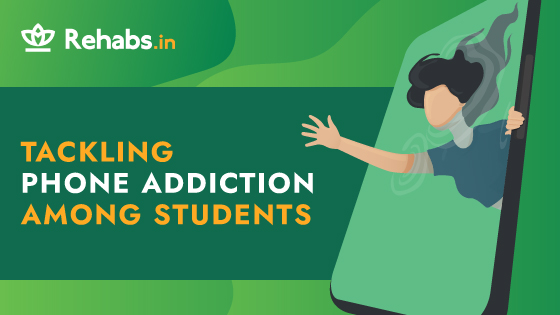Tackling Phone Addiction Among Students

Our smartphones are truly remarkable devices, always by our side like a reliable companion. They offer entertainment, provide distractions from challenging situations, and the internet and social media have elevated our connectivity to new heights, haven’t they? Feeling down? Just grab your phone and start scrolling – instant distraction.
But is this constant phone use as fulfilling as we once thought? Have you ever felt drained after spending too much time on your phone? Perhaps you’ve experienced guilt, realising you’re neglecting other important aspects of your life – friends, work, studies, hobbies. Suddenly, what seemed like harmless entertainment starts feeling like an escape that creates more problems than it solves.
As parents, guardians, or educators, it’s natural to be concerned about the excessive use of phones and the internet in today’s digital era. The developing minds of children and adolescents are highly impressionable, and every piece of information they consume shapes their values, beliefs, and personality.
In our blog, we’ll share valuable tips on how to stop phone addiction for students and foster healthier digital habits.
Intro
On average, most individuals spend approximately 3 hours and 15 minutes on their smartphones daily. This habitual use of smartphones among adolescents disrupts their sleep patterns, negatively impacting their short-term memory. Studies reveal that the average daily smartphone usage peaks at age 16, reaching around 6.35 hours per day. Furthermore, excessive smartphone usage is significantly correlated with impulsivity, anxiety, depression, attention deficits, and somatic problems among individuals aged 17-19.
The consequences of smartphone addiction extend beyond mental health, manifesting in physical health issues such as sleep disorders, musculoskeletal problems, and neurological complications. Additionally, smartphone addiction is associated with detrimental effects on academic performance, including increased procrastination, impulsivity, reduced self-esteem, limited social interaction, heightened solitude, and elevated suicide risks.
While smartphones can be beneficial in facilitating communication and accessing information swiftly, their potential negative impact on individuals through distractions, multitasking, and health concerns is well-documented in the literature. Studies have indicated that higher smartphone usage is linked to a decline in academic performance.
Addressing smartphone usage among students has become an urgent priority. Instead of engaging in activities that contribute to their overall growth, such as socialising, studying, and learning new hobbies, adolescents often find themselves absorbed in social media or gaming on their phones. This behaviour not only disconnects them from meaningful interactions with friends but also compromises their mental and physical well-being, as well as their academic success.
What is Phone Addiction?
The concept of cell phone or smartphone addiction has gained significant attention in research, blogs, and online searches. However, the question remains: is cell phone addiction a legitimate disorder? It’s undeniable that excessive cell phone use poses a problem for many individuals. Yet, there exists a debate among medical and mental health professionals regarding whether problematic cell phone use should be classified as an addiction or as an impulse control issue.
Similar to other behavioural addictions, there is resistance in acknowledging cell phone addiction as a clinical diagnosis. Notably, cell phone addiction is not listed in the Diagnostic and Statistical Manual of Mental Disorders (DSM) or the International Classification of Diseases (ICD). However, it’s worth noting that the 11th edition of the ICD does recognise two behavioural addiction disorders: Gambling disorder and gaming disorder.
Let’s delve into the signs of phone addiction based on the criteria outlined for behavioural disorders in the ICD.
- Using the phone a lot and not being able to stop or reduce how often and how long they use it.
- Giving more importance to phones than other activities and interests.
- Using phones too much even when it causes problems like headaches, eye pain, falling behind in school, not sleeping well, or having issues with family or friends.
- Phones causing big problems in family, social life, school, and other important parts of life.
Other signs might include:
- Trying many times to use the phone less but not succeeding.
- Feeling a strong urge to use the phone while doing other things.
- Having major problems with sleep, eating, exercise, and overall health.
- Hiding the extent of their phone use and the problems it causes.
- Using the phone too much to cope with feelings of sadness, worry, boredom, or feeling alone.
- This might happen along with other problems like using substances, feeling down, anxious, or having trouble with personality.
It’s crucial to understand that using the phone frequently doesn’t automatically mean someone has a phone addiction. Behavioural addictions are only diagnosed when there’s a lot of distress, and the signs mentioned above are present.
Setting Boundaries
Phones can be a significant distraction for students, diverting their attention away from their academic responsibilities. It’s crucial to implement specific rules and boundaries to mitigate these distractions. Establish clear guidelines regarding phone usage during study sessions or class time. Designate “no-phone zones” in areas like bedrooms, study spaces, or the dining table where phones are not allowed. Create a schedule for phone usage and ensure students adhere to it. Here are a few tips for maintaining these rules and boundaries with students:
- Consistent Enforcement: Ensure that rules regarding phone usage are consistently enforced by both parents, other guardians and teachers.
- Communicate Effectively: Clearly communicate the reasons behind the rules to students. Help them understand how excessive phone use can impact their academic performance and overall well-being.
- Provide Alternatives: Encourage students to engage in alternative activities that promote focus and productivity, such as reading, studying with classmates, or participating in extracurricular activities.
- Lead by Example: Model healthy phone habits yourself. Show your children or students that you also adhere to the established rules and boundaries regarding phone usage.
Using Productivity Tools
In today’s digital era, while there are numerous negative effects of technology on mental health and overall wellbeing, there are also considerable advantages. One effective way to combat excessive phone usage is by utilising productivity tools such as applications that help limit phone usage.
Additionally, utilising planners or habit-tracking applications can aid in establishing routines and implementing effective time management techniques. These apps allow you to designate phone-free periods for studying or socialising.
Here are a few examples:
- Forest: This app encourages productivity by growing a virtual tree for every set period of focused work. If you leave the app to check your phone, the tree dies, motivating you to stay focused.
- Moment: Moment tracks your screen time and app usage, allowing you to set daily limits and receive notifications when you exceed them. It also provides insights into your digital habits.
- Flipd: Flipd helps you stay focused by temporarily locking your phone for a set period. During this time, you can’t access distracting apps, promoting productivity.
- Habitica: Habitica gamifies habit tracking by turning your tasks and goals into a role-playing game. Completing tasks earns you rewards and helps you stay motivated.
- Streaks: Streaks helps you build positive habits by tracking your progress and encouraging consistency. You can set daily goals and monitor your streaks to stay on track.
Many iOS and Android phones come with built-in screen time settings that allow you to set limits for each app. Once you reach the limit, you’re restricted from accessing those apps for the remainder of the day. Alternatively, you can set reminders to take breaks from your phone and engage in other activities to promote a healthy balance.
Practicing Mindfulness
Phones have a way of captivating our attention to the point where we often lose track of time. You might have experienced picking up your phone with a specific task in mind, only to realise an hour later that you’ve been engrossed in notifications and social media, forgetting your original purpose. It’s essential to cultivate mindfulness and awareness of our phone usage habits. This can also help you have a healthy relationship with social media.
One way to start is by recognising when we tend to use our phones excessively and practising mindfulness in those moments. Mindfulness is a skill that improves with practice, beginning with neutral situations before applying it to more challenging ones. Simple mindfulness exercises can help reduce impulsivity and enhance self-awareness.
Here’s a brief mindfulness exercise you can try:
- Find a quiet and comfortable space to sit or lie down.
- Close your eyes and take a few deep breaths, focusing on the sensation of your breath entering and leaving your body.
- Gradually shift your attention to the present moment, noticing any sounds, sensations, or thoughts without judgment.
- If your mind wanders, gently guide your focus back to your breath or the present moment.
- Continue this practice for a few minutes, gradually increasing the duration as you become more comfortable.
Forming Healthy Habits
The more time we dedicate to our phones, the less time we have for meaningful connections with loved ones and for ourselves. Simply attempting to reduce phone usage can be challenging because it fulfills certain needs like boredom, loneliness, and the desire for engagement and entertainment. To effectively cut down screen time, it’s crucial to replace it with more fulfilling activities, such as exercise, which has proven benefits for both physical and mental well-being.
You can also rediscover old hobbies or develop new ones. For adolescents, encourage them to explore new interests like learning a musical instrument, trying a new sport, or mastering a new language. Encourage spending quality time with friends in person rather than solely through phones, as face-to-face interactions offer numerous mental health advantages over online communication.
Many people tend to use their phones extensively before bedtime, leading to a phenomenon known as revenge procrastination, where individuals stay up late using their phones as a form of rebellion against a lack of control during the day. Establishing a bedtime routine that involves disconnecting from devices is essential. The light emitted from screens can disrupt the production of melatonin, the sleep hormone. Instead, unwind by reading, listening to calming music, or following a skincare routine before bed to promote relaxation and better sleep quality.
Additionally, follow the 20-20-20 rule to prevent eye strain while using screens. Every 20 minutes, take a 20-second break to look at something 20 feet away. This rule helps reduce eye discomfort and vision issues associated with prolonged screen use.
Getting Support
If controlling your phone usage feels overwhelming, consider confiding in a trusted friend or family member about your difficulties. You can also seek professional help, where you’ll have a safe and non-judgmental space to discuss your challenges. Additionally, look for support groups or online communities where students facing similar issues come together. Remember, reaching out to your teachers or school counsellors is always an option as well. Seeking social or professional support is not a sign of weakness; it demonstrates strength and a commitment to improving your well-being.
Engaging in Alternative Activities
As mentioned earlier, reducing phone usage without replacing it with alternative activities can be quite challenging. To address this, start by listing five activities that help you relax without relying on your phone. These could include:
- Meditation or mindfulness exercises
- Reading a book or listening to music
- Going for a walk in nature
- Practicing yoga or stretching
- Taking a relaxing bath or doing a creative activity like painting or crafting
Next, make a list of five things that you find interesting and stimulating which can contribute to your personal growth and fulfillment. These could be:
- Learning a new language or musical instrument
- Taking up a new hobby like gardening or cooking
- Participating in community volunteering or activism
- Enrolling in a course or workshop on a topic of interest
- Engaging in physical activities like sports or dance classes
Additionally, prioritise making offline connections with people by organising meetups or board game nights with friends. Encourage more face-to-face socialising and plan regular gatherings to strengthen interpersonal connections beyond digital interactions.
Reflecting on Progress
Keep in mind that personal growth is a continuous journey, marked by progress rather than fixating on reaching the final goal. Focus on acknowledging and celebrating small achievements along the way to stay motivated. You can celebrate small milestones by treating yourself to something special, like a favourite meal or a relaxing activity.
As you track your phone usage over time, celebrate the progress you make. If certain strategies aren’t effective, don’t hesitate to explore new approaches. Remember, it’s okay to seek support from mental health professionals or counsellors who can provide guidance, identify triggers, and offer new strategies to manage phone usage.
While cell phones aren’t inherently harmful, they can become addictive, especially for children and adolescents. It’s crucial to be mindful of our phone usage and recognise the signs of addiction. Implement the tips mentioned in this article to manage phone usage effectively. If you’re considering professional help other than counsellors, there are also youth de-addiction programs conducted in various rehabs and treatment centres across India.
Sources:
[Smartphone usage among adolescents]. (2015). PubMed. https://pubmed.ncbi.nlm.nih.gov/26471031
Achangwa, C., Ryu, H. S., Lee, J. K., & Jang, J. (2022). Adverse Effects of Smartphone Addiction among University Students in South Korea: A Systematic Review. Healthcare, 11(1), 14. https://doi.org/10.3390/healthcare11010014
Alshoaibi, Y., Bafil, W., & Rahim, M. (2023). The effect of screen use on sleep quality among adolescents in Riyadh, Saudi Arabia. Journal of Family Medicine and Primary Care, 12(7), 1379–1388. https://doi.org/10.4103/jfmpc.jfmpc_159_23
Amez, S., & Baert, S. (2020). Smartphone use and academic performance: A literature review. International Journal of Educational Research, 103, 101618. https://doi.org/10.1016/j.ijer.2020.101618
Ekambaram, G. (2023). Impact of smart phone use on adolescence health in India. Bioinformation, 19(11), 1090–1093. https://doi.org/10.6026/973206300191090
ICD-11 for Mortality and Morbidity Statistics. (n.d.-d). https://icd.who.int/browse/2024-01/mms/en#1041487064
Rouxel, P., & Chandola, T. (2023). No Substitute for In-Person Interaction: Changing Modes of Social Contact during the Coronavirus Pandemic and Effects on the Mental Health of Adults in the UK. Sociology, 003803852311721. https://doi.org/10.1177/00380385231172123
Sharma, A., Madaan, V., & Petty, F. D. (2006). Exercise for mental health. The Primary Care Companion for CNS Disorders, 8(2). https://doi.org/10.4088/pcc.v08n0208a

















